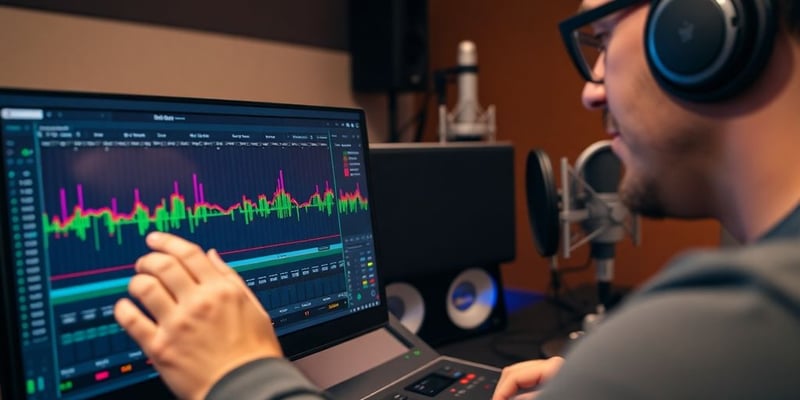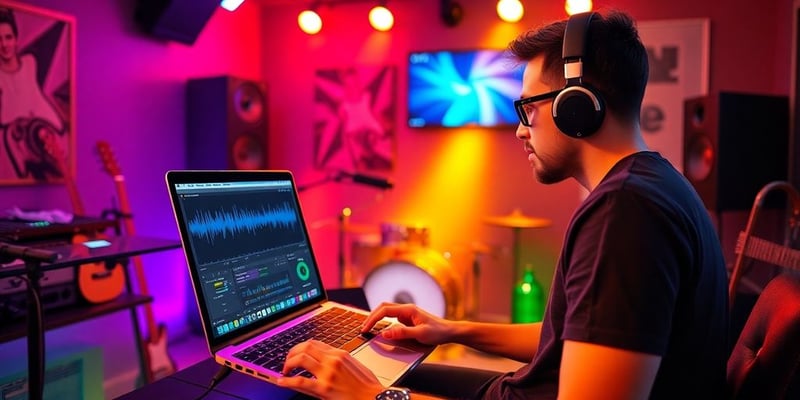
Mastering the Art of How to Autotune: A Comprehensive Guide for Beginners
Save 15%

Getting started with autotuning might seem a bit overwhelming at first, but don't worry—you're not alone! This guide is here to help you understand how to autotune like a pro, even if you're just starting out. We'll break down everything from the basics to more advanced techniques, all in simple terms. Whether you're looking to correct pitch or create cool vocal effects, you'll find what you need right here. Let's dive in and make some music magic!
Key Takeaways
- Autotune is a tool that adjusts the pitch of vocals to match the correct notes, making them sound in tune.
- Understanding the history and features of autotune helps you use it more effectively in your music.
- Setting up autotune involves choosing the right version, installing it, and integrating it with your DAW.
- Experimenting with settings allows you to find the best autotune configuration for your voice.
- Troubleshooting common issues like robotic sounds or artifacts can improve the quality of your autotuned tracks.
Understanding the Basics of How to Autotune

What is Autotune and How Does It Work?
Autotune is a digital tool that tweaks the pitch of your voice to match the nearest musical note. It's like having a pitch-perfect buddy who corrects your singing in real-time. Autotune's charm lies in its ability to make even the most off-key singer sound on point. It works by analyzing the pitch of your voice and shifting it to the closest semitone. This tech marvel can either subtly enhance your vocals or give you that robotic, T-Pain vibe, depending on how you set it up.
The History and Evolution of Autotune
Autotune has an interesting backstory. It all started in the late '90s when a clever geophysicist named Dr. Andy Hildebrand thought of using his seismic data analysis skills to create a tool for music. Initially, it was just a way to correct pitch inaccuracies, but it quickly became a staple in studios worldwide. Over time, it evolved from a simple pitch correction tool to a creative powerhouse that artists use to experiment with their sound.
Key Features of Autotune
Autotune is packed with features that make it a favorite among musicians. Here are some key ones:
- Pitch Correction: The main function of Autotune is to correct pitch, ensuring your vocals are in tune with the music.
- Formant Correction: This feature allows you to tweak the tonal quality of your voice without affecting the pitch, giving you the ability to sound more natural or completely different.
- Retune Speed: Adjusting this can give you anything from a smooth, natural sound to a sharp, robotic effect.
- Humanize and Flex-Tune: These settings help maintain the natural variations in your voice, preventing it from sounding too mechanical.
Autotune isn't just about fixing mistakes; it's a tool for creativity. Whether you're using it to correct pitch or create unique vocal effects, it opens up a world of possibilities for your music. Experiment and see where it takes you!
Setting Up Your Autotune Software
Choosing the Right Autotune Version
Picking the perfect autotune version can feel like choosing a new phone—there's a lot to consider. Auto-Tune Access is great if you're just starting. It's simple and gets the job done without overwhelming you with features. But if you're ready to dive deeper, Auto-Tune Pro might be your best friend. It offers more advanced tools like formant shifting and humanization, perfect for those who want to experiment. Then there's Auto-Tune EFX+, which is all about creativity—think unique vocal effects and fun tweaks. Consider what you need and how much you're willing to spend.
Installing and Configuring Autotune
Once you've picked your version, it's time to get it up and running. Start by downloading the software from the official site. Follow the installation steps, and soon you'll be ready to rock. After installation, open the software and dive into the settings. Make sure to configure it based on your needs. Tweak the retune speed and scale settings to match your project's requirements. Don't rush this part; it's worth spending time getting it just right.
Integrating Autotune with Your DAW
Now, let's talk about making autotune and your DAW work together like peanut butter and jelly. Start by opening your DAW and loading autotune as a plugin. Check if it’s properly recognized. Then, set it up on your vocal tracks. You might need to adjust the buffer size for smooth performance. Also, remember to set the key and scale in autotune to match your song. This way, everything aligns perfectly, and you avoid any weird pitch issues.
Setting up your autotune software is like preparing your kitchen before cooking. You need the right tools, a good setup, and a bit of patience to create something amazing. Take your time, and soon you'll be crafting vocals that sound just the way you imagined.
Mastering Autotune Techniques for Beginners
Finding the Right Settings for Your Voice
Getting the right settings in Autotune is a bit like finding the perfect pair of shoes; it needs to fit just right. Start with identifying the key of your song. You can use tools like a keyboard or a pitch pipe for this. Once you know the key, select the correct scale in Autotune to ensure accurate pitch correction.
Now, let's talk about retune speed. This feature controls how quickly the software corrects the pitch. A slower retune speed gives a natural sound, while a faster one can make your voice sound robotic. Experimenting with different speeds is key to finding what works best for your voice.
Creating Natural-Sounding Vocals
Achieving natural-sounding vocals with Autotune requires a delicate balance. Start by adjusting the "Humanize" and "Natural Vibrato" settings. These features add subtle variations and preserve the natural vibrato of your voice, making it sound less mechanical.
- Humanize Setting: This adds slight variations to the pitch correction, making it sound more human.
- Natural Vibrato: Maintains the natural vibrato of your voice, adding authenticity.
- Record Multiple Takes: Always record several takes with different settings. This gives you options to choose from and helps you find the best sound.
Exploring Creative Autotune Effects
Autotune isn't just about pitch correction. It's also a tool for creativity. You can use it to create unique vocal effects that make your music stand out. Try playing with the "Formant Control" to change the timbre of your voice or use "Flex-Tune" for subtle corrections that keep the natural sound intact.
Don't be afraid to experiment with Autotune's features. The more you play around, the more you'll discover how to use it to enhance your music.
For a deeper dive into mastering Autotune, check out this comprehensive guide on Auto-Tune that covers everything from fundamental concepts to troubleshooting common issues. It's a handy resource whether you're just starting or looking to refine your skills.
Advanced Autotune Settings and Customization
Adjusting Retune Speed and Formant Control
When you're diving into autotune, the Retune Speed setting is one of the most crucial aspects to master. It's the magic dial that decides how quickly your pitch gets corrected. A slower setting gives you a more natural vibe, while cranking it up can make you sound like a robot from the future. It's not just about fixing off notes, but also about finding that sweet spot where your voice feels real. Alongside this, the Formant Control is like adjusting the vocal "color" or timbre. Want to sound a bit deeper or lighter? This is your go-to knob. Experimentation is key here; you might stumble upon a sound that's uniquely yours.
Using Flex-Tune and Humanize Features
Flex-Tune is a neat feature that allows for more subtle pitch correction. It's perfect if you want to keep your vocal's natural nuances intact while still correcting pitch. On the other hand, the Humanize setting can add slight variations to your pitch correction, making it sound less mechanical. These tools are great for ensuring your voice retains its character, especially in genres where authenticity is key. It's like giving your voice a gentle nudge rather than a full-on shove.
Automating Autotune in Your Mix
Automation is where things get really interesting. By automating autotune settings, you can change the retune speed or formant settings dynamically throughout a song. This means you can have a natural-sounding verse and a more robotic chorus, all within the same track. It's a powerful way to add depth and interest to your music. Just think of it as another instrument in your mix, one that can shift and change as your song progresses. This kind of customization can really make your tracks stand out.
Tinkering with autotune settings can feel like a daunting task at first, but remember, every tweak is a step toward discovering your sound. Keep experimenting and let your creativity guide you.
Troubleshooting Common Autotune Issues
Dealing with Artifacts and Unnatural Sounds
When you're working with Autotune, it's not uncommon to run into artifacts and unnatural sounds. These occur when the software overcorrects the pitch, making your vocals sound robotic. To tackle this, try slowing down the retune speed or tweaking the formant control. If the problem persists, consider mixing in some manual pitch correction to smooth things out.
Avoiding Excessive Robotic Effects
Sometimes, you might want that robotic sound, but there's a fine line between cool and overdone. If your track starts to sound too robotic, play around with the retune speed. A slower speed can help keep things natural. Also, don't forget about the humanize feature; it adds subtle variations that make a big difference.
Remember, Autotune is there to enhance your vocals, not overshadow them. Keep experimenting until you find the sweet spot.
Blending Autotune with Manual Pitch Correction
Autotune is powerful, but sometimes it needs a little help. Blending it with manual pitch correction can give you the best of both worlds. Here's a quick guide:
- Identify the parts of your track that need correction.
- Use your DAW's tools to manually adjust the pitch while listening closely.
- Combine these adjustments with Autotune to achieve a polished sound.
Troubleshooting these common issues is all part of the process. With some patience and a bit of trial and error, you'll have your tracks sounding just right.
The Impact of Autotune on Modern Music

Autotune in Pop and Contemporary Music
Autotune has become a staple in pop music, shaping the sound of countless hits over the past two decades. Its ability to create perfectly tuned vocals has allowed artists to achieve the polished sound that defines modern pop. It's no exaggeration to say that autotune has revolutionized the way pop music is produced. From subtle pitch corrections to dramatic vocal effects, autotune has opened up new creative possibilities for artists and producers alike.
- Autotune helps in achieving flawless vocal performances.
- It contributes to the iconic sound of contemporary pop music.
- Artists use it both as a corrective tool and to create unique vocal effects.
Controversies and Criticisms of Autotune
Despite its widespread use, autotune has not been without controversy. Critics argue that it masks vocal imperfections, leading to questions about authenticity in music. Some purists feel that it detracts from the raw, emotional quality of a performance. However, others view autotune as a legitimate artistic tool, akin to other studio effects that enhance a song's overall impact.
- Concerns about authenticity and the "robotic" sound.
- Debates on whether it diminishes the skill of vocalists.
- Seen by some as a tool for creative expression.
Autotune's role in music continues to spark debate, with opinions divided on whether it enhances or detracts from the art form.
Autotune as a Creative Tool in Music Production
Beyond pitch correction, autotune is celebrated for its creative potential. Artists use it to explore new sonic landscapes, crafting sounds that are both innovative and distinctive. By manipulating pitch and formant settings, producers can create effects that range from subtle enhancements to bold, experimental sounds.
- Enables unique vocal effects that stand out.
- Used in various genres to push musical boundaries.
- Offers a range of settings for creative experimentation.
Autotune's continued relevance in the music industry highlights its versatility and enduring appeal. Whether it's used to perfect a vocal track or to create something entirely new, autotune remains a powerful tool in the hands of today's artists.
Wrapping It Up: Your Autotune Journey Begins
So, there you have it. You've got the basics of autotune down, and now it's time to put it all into practice. Remember, autotune is just a tool—it's your creativity that will make your music stand out. Don't be afraid to mess around with different settings, try new things, and see what works best for your sound. Sure, it might be a bit tricky at first, but with some patience and practice, you'll get the hang of it. Keep experimenting, keep learning, and most importantly, keep having fun with it. Who knows? You might just find your own unique sound along the way. Happy autotuning!
Frequently Asked Questions
What is Autotune and how does it work?
Autotune is a tool that fixes the pitch of a singer's voice. It listens to the notes and adjusts them to the nearest correct pitch, helping singers stay in tune.
Why is Autotune so popular in music today?
Autotune is popular because it helps artists sound perfect by fixing any off-key notes. It also allows for creative vocal effects that are trendy in pop music.
Can Autotune change a singer's voice completely?
While Autotune can adjust the pitch and add effects, it doesn't completely change a singer's voice. It enhances the voice but keeps its original character.
Is Autotune only used for fixing pitch?
No, Autotune is also used for creative effects. Some artists use it to make their voices sound robotic or to add interesting sounds to their music.
How do you choose the right Autotune settings?
Choosing the right settings depends on the song and the effect you want. You can experiment with different speeds and settings to find what sounds best.
What should you do if Autotune sounds too robotic?
If Autotune sounds too robotic, you can adjust the settings to make it more natural. Try slowing down the correction speed or blending it with manual pitch changes.









